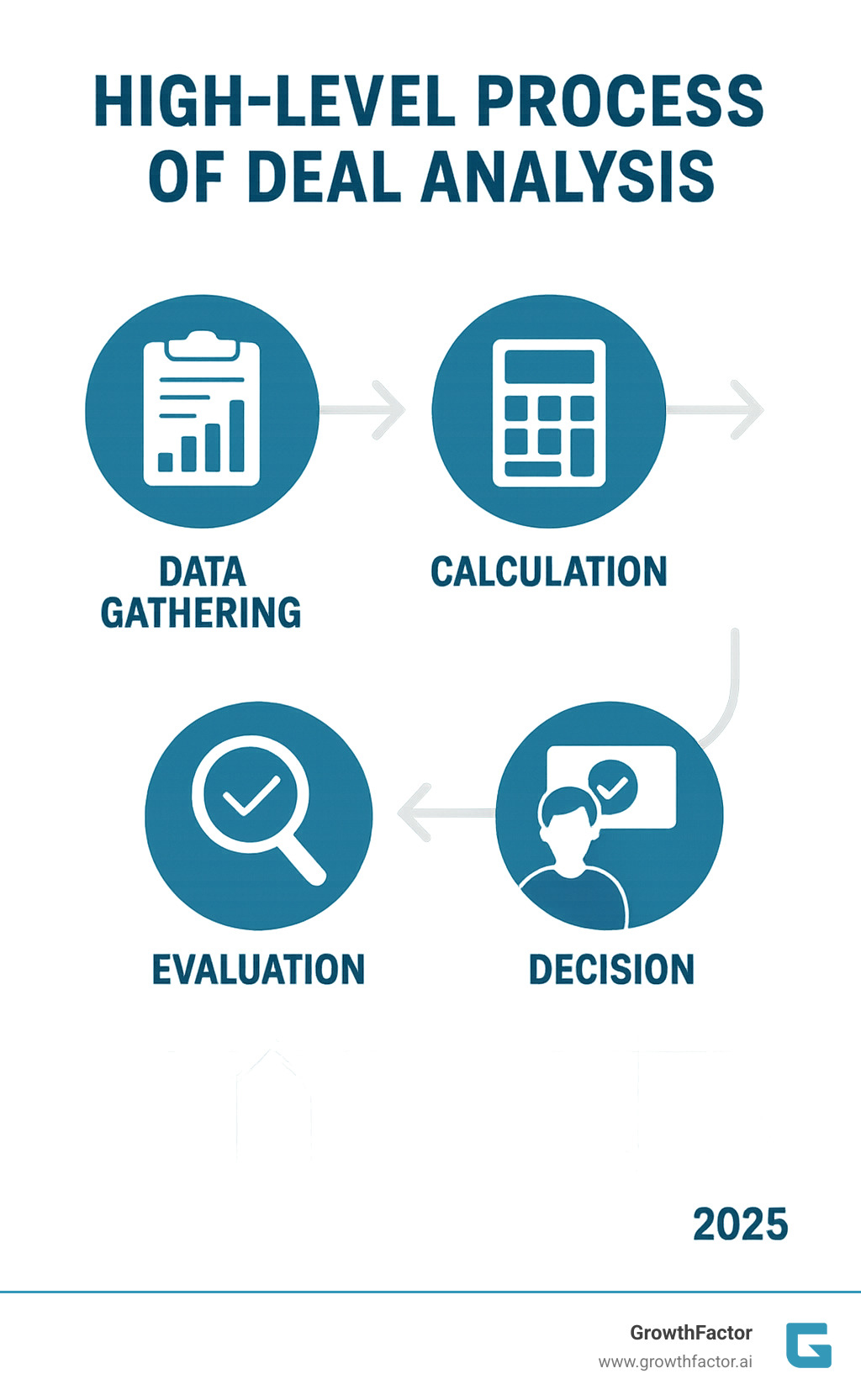The Secret Sauce: Perfect Data Aggregation for Smarter Real Estate Deals
Written by: Clyde Christian Anderson
Opening up Value: The Art and Science of Real Estate Deal Analysis
In real estate investment, success hinges on knowing which properties are truly worth your time and money. This is the core of real estate deal analysis: a systematic process of evaluating a potential investment's profitability, risks, and suitability.
It involves gathering property and market data, calculating key financial metrics (like NOI, cash flow, and ROI), assessing risks, and making a final decision. While many investors rely on intuition, this can lead to costly mistakes. A thorough analysis is crucial because, as the saying goes, "you make your money on the purchase."
This guide will walk you through the essential steps to analyze deals like a pro, helping you make informed, data-driven decisions.
I'm Clyde Christian Anderson, CEO of GrowthFactor.ai. With an MBA from MIT and experience in investment banking and retail real estate, I've dedicated my career to perfecting real estate deal analysis. This passion led to the creation of GrowthFactor, a platform designed to make this complex process faster and more accurate for growing retail brands.

Quick real estate deal analysis terms:
Foundations: Gathering Your Intelligence
Before crunching numbers, you need solid data. Successful real estate deal analysis goes deeper than "location, location, location." It requires understanding market trends and property-specific details.

Different properties require different approaches. Single-family homes are often valued using market comparables, while multi-unit and commercial properties are valued based on the income they generate.
What key factors should be considered when analyzing a real estate investment?
Smart investors focus on four pillars for real estate deal analysis:
- The Property Itself: Evaluate the location, physical condition, income potential, and operating expenses. Use market comparables to ensure you're getting a fair deal.
- The People Factor: Real estate is a people business. Understanding the motivations of sellers, agents, lenders, and tenants can turn a mediocre deal into a great one.
- External Forces: You can't control factors like economic shifts, regulatory changes, or demographic trends, but you must plan for them.
- Capital Markets: Your financing options and interest rates are critical. Even small rate changes can dramatically impact your returns and cash flow.
How do I gather and verify data for property analysis?
The golden rule is: never trust, always verify. Sellers often provide "pro forma" projections, which are best-case scenarios. Your job is to find the actual numbers.
Start with public records for unbiased property details and tax history. Review seller disclosures and tax returns, but cross-check them with maintenance records and property management reports. For income verification, research sales and rental comps yourself and talk to local property managers for realistic rent and vacancy estimates.
On the expense side, demand detailed breakdowns and actual invoices for taxes, insurance, maintenance, and utilities. If a number seems too good to be true, it probably is.
Modern Real Estate Data Intelligence tools can provide these insights in a fraction of the time. Due diligence is critical; the time spent verifying data upfront can save you thousands later.
The Core Calculations: From Gross Income to Cash Flow
With solid data in hand, it's time to dive into the numbers. This is where we transform raw data into clear insights, determining if a deal is a winner.

Successful real estate investing boils down to one thing: positive cash flow. This is the money left over after all bills are paid. The calculation follows a clear path from gross income to your take-home pay.
At GrowthFactor, our AI Agent Waldo excels at these calculations, helping clients evaluate sites with speed and accuracy. We believe AI for Asset Managers is a game-changer, freeing you to focus on smart decisions, not spreadsheets.
How do I calculate Net Operating Income (NOI)?
Net Operating Income (NOI) is the property's report card, showing its profitability before financing and taxes. It measures the property's performance based on its income and operational costs alone.
The formula is:
NOI = (Gross Potential Rent + Other Income) - Vacancy - Operating Expenses
- Gross Potential Rent & Other Income: The total rent you'd collect at 100% occupancy, plus any extra income from laundry, parking, or other fees.
- Vacancy: An estimate for lost income from empty units or non-paying tenants.
- Operating Expenses: The regular, ongoing costs to run the property, such as property taxes, insurance, routine maintenance, management fees, and utilities.
Crucially, NOI excludes debt service (mortgage payments), income taxes, and large capital expenditures (CapEx) like a new roof. This gives you a pure look at a property's earning power.
How do I determine a property's cash flow?
For buy-and-hold investors, cash flow is the ultimate prize. It's the actual money that lands in your bank account after all bills are paid, including your mortgage.
The formula is simple:
Cash Flow = Net Operating Income (NOI) - Annual Debt Service
For example, if a property has an annual NOI of $37,169 and your annual mortgage payments are $25,548, your annual cash flow is $11,621, or about $968 per month.
Consistent positive cash flow is the oxygen for your investment, providing a buffer for unexpected repairs or vacancies. A negative cash flow means you're losing money each month, a major red flag. If you use a mortgage (a leveraged purchase), your loan payments directly reduce your cash flow. If you buy with all cash, your cash flow equals your NOI, as there is no debt service.
Advanced Metrics for a Deeper Real Estate Deal Analysis
While NOI and cash flow are essential, sophisticated investors dig deeper with advanced metrics. These tools help compare opportunities and understand the true nature of an investment.
Metrics like Capitalization Rate, Cash-on-Cash Return, and Total ROI each answer a different question about value, risk, and return. Tracking these across all assets is simple with Commercial Real Estate Portfolio Management solutions. Together, they provide a comprehensive view that separates good investors from great ones.
What is the Capitalization Rate (Cap Rate) and how is it calculated?
The Capitalization Rate (Cap Rate) is a cornerstone of real estate deal analysis, offering a quick way to measure a property's potential return relative to its price.
Cap Rate = Net Operating Income (NOI) ÷ Property's Current Market Value
For example, a property generating $50,000 in NOI that costs $625,000 has an 8% Cap Rate. This metric makes it easy to compare properties. A lower Cap Rate often indicates lower risk and a higher price (common in prime locations), while a higher Cap Rate suggests higher risk but potentially greater returns.
Cap rates vary by market and property type. A Class A office building might trade at a 5% Cap Rate, while a fixer-upper apartment complex might demand 9% to compensate for the extra work.
How do I calculate Cash-on-Cash Return (COC)?
Cash-on-Cash (COC) Return is vital when using a mortgage. It measures how well your actual cash invested is performing.
Cash-on-Cash Return = (Annual Pre-Tax Cash Flow ÷ Total Cash Invested) × 100
Total cash invested includes your down payment plus all out-of-pocket closing costs and initial repair expenses. If your annual cash flow is $7,200 and you invested $60,000 in total, your COC return is 12%.
For leveraged investors, this metric is pure gold. It shows how hard your money is working and helps you prioritize where your limited capital will generate the best returns.
What is the total Return on Investment (ROI) and how is it calculated?
Total ROI captures the complete wealth-building picture by accounting for all the ways real estate makes money: cash flow, equity buildup, and appreciation.
Total ROI = (Annual Cash Flow + Principal Paydown + Appreciation) ÷ Total Investment Basis
- Cash Flow: The money in your pocket each year.
- Principal Paydown: The portion of your mortgage payment that builds equity.
- Appreciation: The increase in the property's value over time.
This holistic view shows why real estate is so powerful. A property might generate a 26% total ROI when all three components are combined, far outpacing typical returns from stocks or savings accounts. While real estate requires active management, the potential returns can be substantial for investors who do their homework.
Making the Call: Valuation, Rules of Thumb, and Modern Tools
After the data gathering and number crunching, it's time to make the call. This final stage of real estate deal analysis involves synthesizing your findings, applying practical guidelines, and leveraging technology.
Common valuation methods include Comparative Market Analysis (CMA) for residential properties, Capitalization Rate for income properties, and Gross Rent Multiplier (GRM) for quick screening. However, there is no single exact value for any property. We must resist making emotional decisions, especially in volatile markets, and rely on analytics, not just intuition. This is where advanced tools for AI Real Estate Underwriting come into play.
What are the general guidelines or rules of thumb for rental property investments?
Rules of thumb are quick screening tools to filter out bad deals, not substitutes for detailed analysis.
- The 1% Rule: Gross monthly rent should be at least 1% of the purchase price. A $200,000 property should rent for at least $2,000/month. It's a quick check for positive cash flow potential.
- The 50% Rule: Assumes operating expenses (excluding mortgage) will be about 50% of gross income. It's a conservative estimate for quick, back-of-the-napkin calculations.
- The 70% Rule (for flips): States that an investor should pay no more than 70% of the After-Repair Value (ARV) minus repair costs. This helps ensure a sufficient profit margin.
If a property doesn't pass these initial tests, it's often best to move on without wasting time on a full analysis.
How can technology and tools assist in real estate deal analysis?
In today's market, manual calculations and outdated spreadsheets are too slow and prone to error. Technology is a competitive necessity for effective real estate deal analysis.
Dedicated software and AI-powered tools offer significant advantages:
- Speed: Analyze potential investments in seconds, allowing you to evaluate far more opportunities.
- Accuracy: Reduce human error in complex financial calculations.
- Centralization: Keep all property data, projections, and reports in one organized place.
- Reporting: Instantly generate professional reports for lenders, partners, or clients.
- Automation: AI can automate tedious qualification and evaluation processes, freeing up your team for strategic decisions.
Our Real Estate Investment AI platform at GrowthFactor is designed for this purpose. Our AI Agent, Waldo, streamlines site selection and deal tracking, enabling teams to evaluate more opportunities with greater efficiency. This technology is a game-changer for investors and growing retail brands in dynamic markets across the United States, including Boston, MA, and Cambridge, MA.
Frequently Asked Questions about Real Estate Deal Analysis
Investors often have similar questions, whether they're just starting out or are seasoned pros. Here are answers to some of the most common ones.
What is the most important metric in real estate analysis?
There is no single "most important" metric; the best one depends on your investment strategy.
- For long-term passive income ("buy and hold"), cash flow is king. It ensures the property is self-sustaining.
- For fix-and-flip projects, total Return on Investment (ROI) is crucial, as it captures the full profit from a quick turnaround.
- When comparing different commercial properties, the Capitalization Rate (Cap Rate) is a handy tool for quickly assessing value and market risk.
- For complex, long-term projects, the Internal Rate of Return (IRR) provides a more nuanced view of returns over time.
A thorough real estate deal analysis uses a combination of these metrics to build a complete picture that aligns with your goals.
How much should I budget for maintenance and repairs?
Budgeting for upkeep is critical to protecting your profits. While there's no perfect number, here are some guidelines:
- A common rule is to set aside 5% to 15% of the gross rent for maintenance. Newer properties will be on the lower end, while older properties will require more.
- The 50% Rule offers a conservative, broad estimate that half of your rental income will go toward all operating expenses, including maintenance and repairs.
- It's also wise to build a Capital Expenditures (CapEx) reserve for large, infrequent expenses like a new roof or HVAC system. Budgeting 1% of the property's value annually is a common practice.
Always get a professional inspection to uncover potential issues and base your budget on the property's actual age and condition.
What is the difference between an appraisal and a deal analysis?
Though both assess a property's value, they serve different purposes.
An appraisal is a formal, unbiased opinion of a property's current market value, conducted by a licensed appraiser. Its primary purpose is to protect a lender by ensuring the property is sufficient collateral for a loan.
A real estate deal analysis, on the other hand, is your personal evaluation to determine if a property is a good investment for you. It's performed by you, the investor, and focuses on future profitability, cash flow, and ROI based on your specific financial goals and risk tolerance.
In short, an appraisal tells a bank what a property is worth to them, while a deal analysis tells you what it's worth to you.
Conclusion
We've journeyed through the essentials of real estate deal analysis, turning complex data into a clear path for smarter investing. The key takeaway is that success in real estate is built on a repeatable, data-driven process, not luck or gut feelings.
By gathering accurate intelligence, calculating core metrics like NOI and cash flow, and leveraging advanced tools like Cap Rate and ROI, you can build a robust financial picture of any deal.
In today's market, technology is the ultimate strategic advantage. It allows you to analyze deals faster, more accurately, and with greater confidence. That's where GrowthFactor steps in. Our AI-powered platform, featuring our AI Agent Waldo, is designed to streamline site selection and deal tracking for investors and growing retail brands. It automates tedious evaluations, allowing you to assess more opportunities and make smarter decisions.
Ready to transform your investment approach? Explore our solutions, like those for Private Equity Portfolios, and let GrowthFactor be your partner in building a data-driven and successful real estate future.
Citations
The human algorithm
Request Your demo
Schedule meeting
Or submit your information below and we'll be in touch to schedule.




